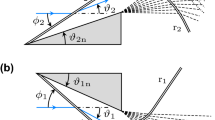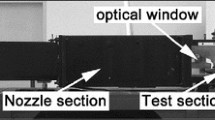Abstract
The present paper describes experimental investigations for shock oscillations caused by normal shock wave/turbulent boundary layer interaction in a supersonic diffuser. An array of wall-mounted transducers and especially a line image sensor for the nonintrusive detection of shock displacements were employed to investigate the interactions at low supersonic speeds. The line image sensor was collimated with a conventional schlieren optical system and was a good indicative of capturing the shock oscillating motions in the present configuration. This study shows that the amplitude of the shock motions increases with approaching flow Mach number, and the cause of oscillation of the shock wave can, however, be independent of the Mach number. In addition, the present system employed to determine the shock wave positions and displacements can be effectively applied to a variety of practical problems.
Similar content being viewed by others
References
Ackeret J, Feldman F, Rott N (1947) Investigations of compression shocks and boundary layers in gases moving at high speed. NACA TM-11113
Anderson JS, Jungowski WM, Hiller KJ, Meier GEA (1977) Flow oscillations in a duct with a rectangular cross-section. J Fluid Mech 79, 4:769–784
Andreopoulos J, Muck KC, Dussauge JP, Smits AJ (1987) Some new aspects of the shock wave boundary layer interaction in compression ramp flows. J Fluid Mech 180:405–428
Bendat JS, Piersol AG (1971) Random data: analysis and measurement procedures. John Wiley & Sons, Inc.
Bogdonoff SM, Kepler CE (1955) Separation of a supersonic turbulent boundary layers. J Aero Sci 22:414–424
Bohning R, Zierep J (1980) Normal shock-turbulent boundary layer interaction at a curved wall. AGARD CP-291
Chyu WJ, Hanly RD (1969) Power and cross spectra and space-time correlations of surface fluctuating pressure at Mach numbers between 1.6 and 2.5. NASA TN-D-5440
Culic FEC, Rogers T (1983) The response of normal shocks in diffuser. AIAA J 21, 10:1381–1390
Delery J, Marvin JG (1986) Shock-wave boundary layer interactions. AGARDograph No 280
Dolling DS, Brusniak L (1987) Separation shock motion in fin, cylinder and compression ramp-induced turbulent interactions. AIAA Paper 87–1368
Doiling DS, Murphy MT (1983) Unsteadiness of the separation shock wave structure in a supersonic compression ramp flowfield. AIAA J 21:1628–1634
Dolling DS, Or CT (1985) Unsteadiness of the shock wave structure in attached and separated compression ramp flows. Exp in Fluids 3:24–32
Green JE (1969) Interaction between shock-waves and turbulent boundary-layers. RAE TR-69098
Kim HD, Matsuo K, Kawagoe S, Kinosita T (1991) Flow unsteadiness by weak normal shock wave/turbulent boundary layer interaction in internal flow. JSME International Journal Series II 34, 4:457–465
Kim YN, Buggelin RC, McDonald H (1986) Numerical analysis of some supersonic viscous flows related to inlet and nozzle systems. AIAA Paper 86-1597
Kistler AL (1964) Fluctuating wall pressure under a separated supersonic flow. J Acoust Soc Amer 36, 3:543–550
Kuehn DM (1961) Turbulent boundary-layer separation induced by flares on cylinders at zero angle of attack. NASA TR-R-117
Meier GEA (1976) Shock induced flow oscillations in a laval nozzle. IUTAM Symp Transsonicum II, Springer Verlag, 252–261
Muck KC, Smits AJ (1984) Behavior of a turbulent boundary layer subjected to a shock-induced separation. AIAA Paper 84–0097
Nussdorfer TJ (1956) Some observations of shock-induced turbulent separation in supersonic diffusors. NACA RM1L26
Pearcey HH (1955) Some effects of shock-induced separation of turbulent boundary-layer in transonic flow past aerofoils. ARC R&M 3108
Pearcey HH, Osborne J, Haines AB (1968) The interaction between local effects at the shock and rear separation — a source of significant scale effect in wind-tunnel tests on aerofoils and wings. AGARD CP-35
Reddy DR, Weir LJ (1992) Three-dimensional viscous analysis of a Mach 5 inlet and comparison with experimental data. I Propulsion and Power 8, 2:432–440
Sajben M, Morris MJ, Bogar TJ, Kroutil JC (1991) Confined normal-shock/turbulent-boundary-layer interaction followed by an adverse pressure gradient. AIAA J 29, 12:2115–2122
Seegmiller HL, Marvin JG, Levy Jr LL (1978) Steady and unsteady transonic flow. AIAA Paper 78–160
Settles GS (1975) An experimental study of compressible turbulent boundary layer separation at high Reynolds number. Ph.D. Dissertation, Univ of Princeton, USA
Smits AJ, Muck KC (1987) Experimental study of three shock wave/turbulent boundary layer interactions. J Fluid Mech 182:291–314
Speaker WV, Ailman CM (1969) Spectra and space-time correlations of the fluctuating pressures at a wall beneath a supersonic turbulent boundary layer perturbed by steps and shock waves. NASA CR-486
Tran TT (1987) An experimental investigation of unsteadiness in swept shock wave/turbulent boundary layer interactions. Ph.D. Dissertation, Univ of Princeton, USA
Author information
Authors and Affiliations
Additional information
This article was processed using Springer-Verlag TEX Shock Waves macro package 1.0 and the AMS fonts, developed by the American Mathematical Society.
Rights and permissions
About this article
Cite this article
Matsuo, K., Kim, H.D. Normal shock wave oscillations in supersonic diffusers. Shock Waves 3, 25–33 (1993). https://doi.org/10.1007/BF01414745
Received:
Accepted:
Issue Date:
DOI: https://doi.org/10.1007/BF01414745




